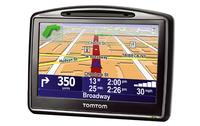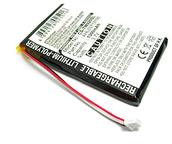The Great TomTom Battery Adventure
![]()
![]()

The TomTom automobile GPS receivers are a wonder of very small technology. Accurate, easy to use and upgradeable so they sound like Homer Simpson when they’re telling you to turn left in five-hundred meters, these are the expensive little boxes to have suction-cupped to your windshield when you’re hopelessly lost.
We have a TomTom GO 630. Despite the occasional spate of bad press these things engender when someone drives through a shopping mall having blindly followed their instructions, we’ve never found ourselves in a lake, demolishing plate glass or mowing down sheep as a result of its navigation.
In fact, of late, it hasn’t even interrupted our conversations, in that several months after its warranty expired, so did its internal battery. In the space of a few weeks, it went from holding a charge for a fortnight to holding a charge for something less than the duration of a quick trip into town for snacks.
The disturbing aspect of a TomTom with a dead battery is that, in so far as I was able to determine, the cost of getting it repaired is somewhat ambiguous. Repeated telephone calls and e-mail messages to TomTom’s support staff produced a remarkable amount of monkey dandruff, but nothing that could have been mistaken for a repair quote, or an address to ship the little brick to.
TomTom replied with a lot of:
I understand that your device battery does not hold charge. We truly understand how frustrating this kind of issue can be. I am here to assist you and will certainly try to resolve the issue. This issue might have caused if the device is not properly charged. It may also cause if the device or the charging cord does not function properly. Please make sure that you have charged the unit in the manner specified below and then reset the unit. Once the unit is properly charged and reset, the unit should power on. Ideally, the device should be charged completely, when charged for 3 to 4 hours. We also have tips to extend the battery life on the TomTom web site. It was a pleasure assisting you. In case, the issue persists, please reply and let us know the status of the issue. We will be more than glad to assist you. Your satisfaction towards our product and support is our prime objective.
I should note that replacing the battery in a TomTom and replacing the battery in a flashlight or a digital camera are similar only in that all these devices use batteries. In the case of a TomTom, the battery is wired to the circuit board of the device, inside a case held together with very small non-standard screws that have almost certainly been selected to make the whole works just this side of impossible to repair.
After several attempts to pry some answers out of TomTom, I resorted to Google. It seemed likely that someone else must have noticed their GO 630 lapsing into blackness moments after it was powered up, and found solace in a battery replacement. This proved wholly fruitful, although not in quite the way I’d initially imagined.
I was unable to find any accounts of TomTom users successfully persuading the manufacturer of these devices to fix them. However, remarkably few had even tried. It turned out that there’s a vast industry of third-party battery replacement suppliers for portable technology. Users of deceased TomToms can fix them in house.
The odds-on favorite source for replacement TomTom batteries seems to be a Wyoming retailer called BatteryShip.com. For $22.25, they offered a replacement battery for the GO 630, a package of tiny tools to de-encase the beast and free shipping. Their web page included a set of step by step instructions for opening the GO 630 – which is a hair-raising and somewhat ineffable process unless you know what to unscrew and where to pry.
 In fairness, the battery that arrived from BatteryShip.com was cheap and made in China. I can’t hold this against them, however, as the battery that I eventually extracted from the deceased TomTom was equally cheap and made in China. The replacement battery came in packaging with a few spelling errors – “keep the contact pints clean,” for example – but the battery did prove to be of the right size and type to return our TomTom to the road.
In fairness, the battery that arrived from BatteryShip.com was cheap and made in China. I can’t hold this against them, however, as the battery that I eventually extracted from the deceased TomTom was equally cheap and made in China. The replacement battery came in packaging with a few spelling errors – “keep the contact pints clean,” for example – but the battery did prove to be of the right size and type to return our TomTom to the road.
Anyone with reasonable eye-hand coordination and no serious history of being unworkably dangerous around hand tools can successfully replace the battery in a TomTom with the assistance of a suitable box of bits from BatteryShip.com. It took me about fifteen minutes, which included a rummage around the basement to find a tube of silicon glue to attach the new battery to the TomTom’s circuit board.
Upon reversing the disassembly procedure – you’ll want tweezers and a magnifying glass to complete the work – our formerly comatose GO 630 booted up and began looking for its satellites, oblivious to the minor surgery it had just endured. Its new battery proved amenable to holding a charge. The highway beckons.
I suspect that the entire cost of the battery replacement from BatteryShip.com worked out to less than what it would have cost to ship the GO 630 back to its creator, had I eventually managed to pry a return authorization out of TomTom. In that our GO 630 was off warrantee, actually fixing it would have beat up my credit card further.
While opening the TomTom GPS and meddling with its inner workings does embody the decided risk of permanently bricking the device if the gods aren’t amused by your undertaking – and we accept no responsibility for any loss, damage, expense, injury or madness resulting from your efforts – there’s little to lose in the attempt if your GPS receiver is essentially unusable as it stands. If you succeed in breaking your TomTom, BatteryShip.com offers a no-questions-asked return policy for its batteries.
As a potentially related comment, I have also found my TomTom battery mysteriously not able to hold a charge. I put up with it as would run it from the car’s power anyway and that was sufficient to make it work.
However the cause of the problem manifested itself early one one morning in my study when suddenly, and also mysteriously, and indeed someone eerily, I heard someone speaking to me about my current direction – the unit had switched itself on without human assistance and presumably would bleat away until it ran out of power.
I’ve been wondering if it had a special sensor allowing it to run power down under cover of darkness.